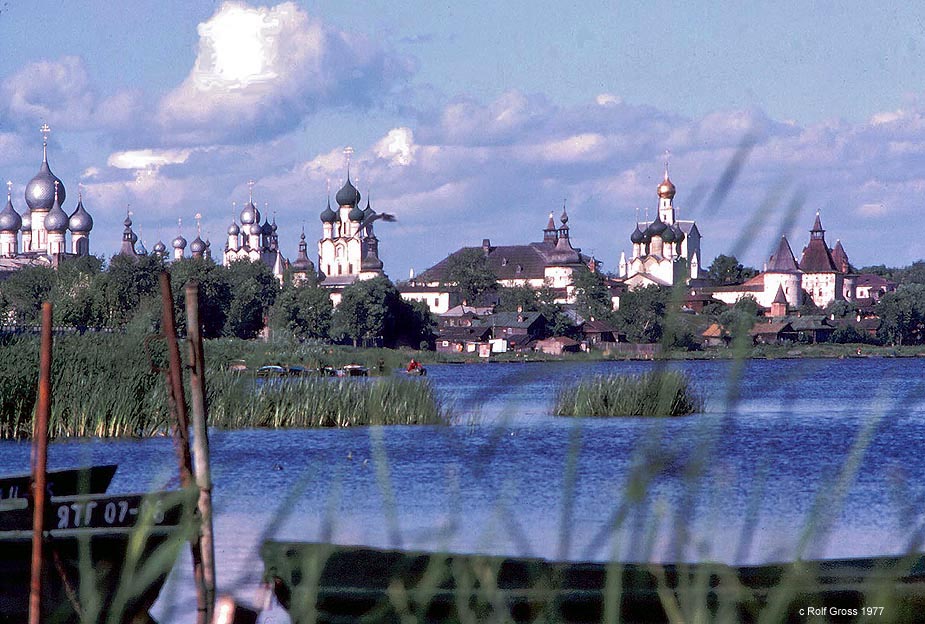
Photo RWFG 1977
The towers of the Kreml from Lake Nero
Church of the Savior-in-the-Market
17th cent
Rostov
Veliki
Link to Google-Earth file Rostov.kmz
This requires that you have GE on your hard disc.
History of Rostov Veliki
Rostov
was predated by Sarskoye Gorodishche, which some scholars interpret
as the capital of the Merya tribe, while others believe it was an
important Viking trade enclave and fortress guarding the Volga trade
route. First mentioned in the year 862 as an already important
settlement, by the 13th century, Rostov became the capital city of
one of the most prominent Russian principalities. It was incorporated
into Muscovy in 1474.
Even after it lost its independence,
Rostov was still an ecclesiastic center of utmost importance (from
988 it was the see of one of the first Russian bishoprics). In the
14th Century, the bishops of Rostov became archbishops, and late in
the 16th century, metropolitans. One of those metropolitans, Iona
(Jonah) Sysoevich (ca. 1607-1690), commissioned the town's main
landmark: the Kremlin, one of the finest outside of Moscow.
The
history
of the restoration of Rostov (1950-70) is described in a lengthy
article by RF Alitova
and TL Nikitina. More
interesting are the photos
of the restorations that accompany it.
Kreml
of Rostov Veliki
10th, 16th-17th cent

Photo RWFG 1977
The towers of the Kreml from Lake
Nero
Church of the
Savior-in-the-Market
17th cent
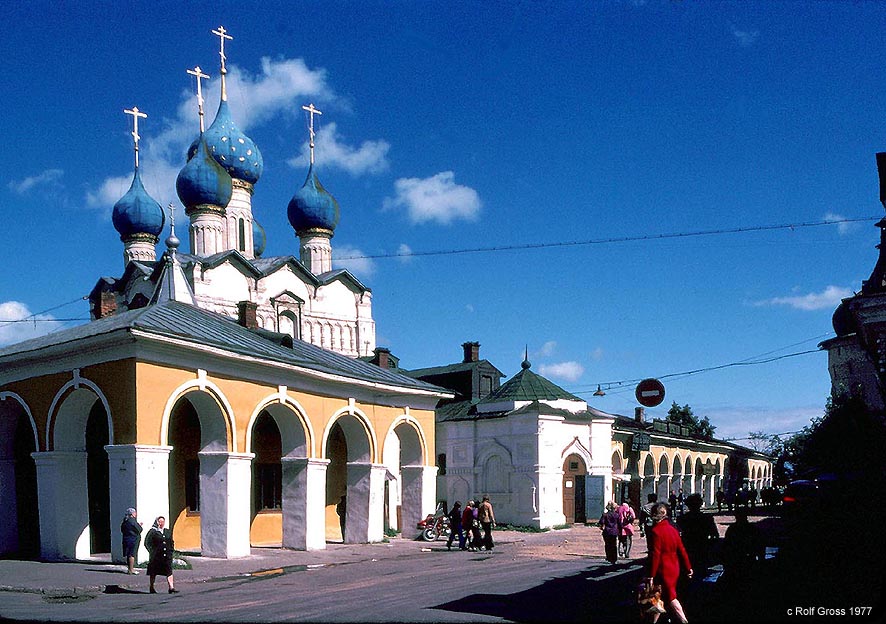
Photo RWFG 1977
The Church of the Savior in the
Market of Rostov.
The new paint was provided by Mosfilm which
was making a movie! Today Rostov appears again in bad repair.
The
Great Wall of Rostov Veliki
16th-17th cent
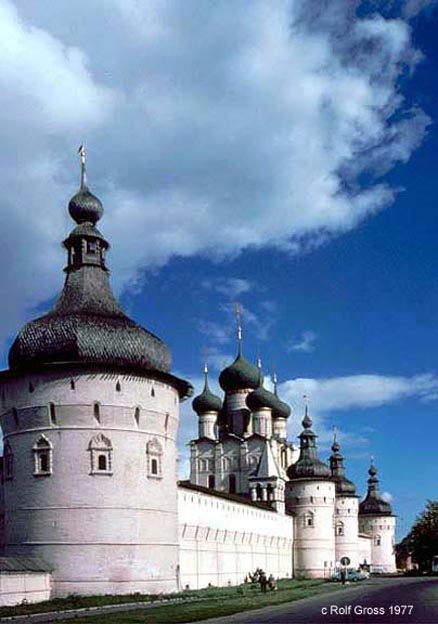
Photo RWFG 1977
Wall and towers of the Rostov Kreml
Church over the
Gate
17th cent
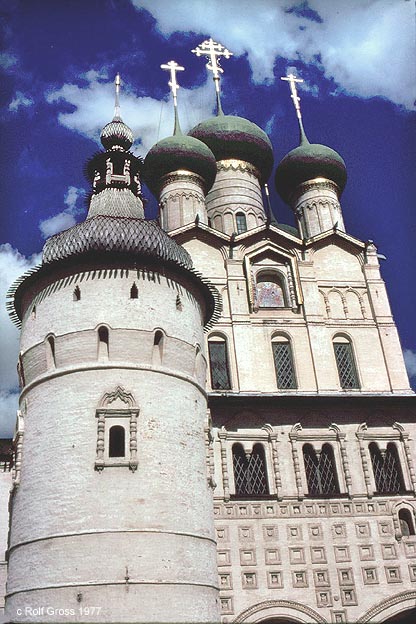
Photo RWFG 1977
The gate is protected by an icon of
the Virgin - which was considered more effective than cannons.

Photo RWFG 1980
Interior, entrance into the
second-floor church. Every surface is painted from the cupola to the
floor.
The
Belltower of the Assumption Cathedral
1162
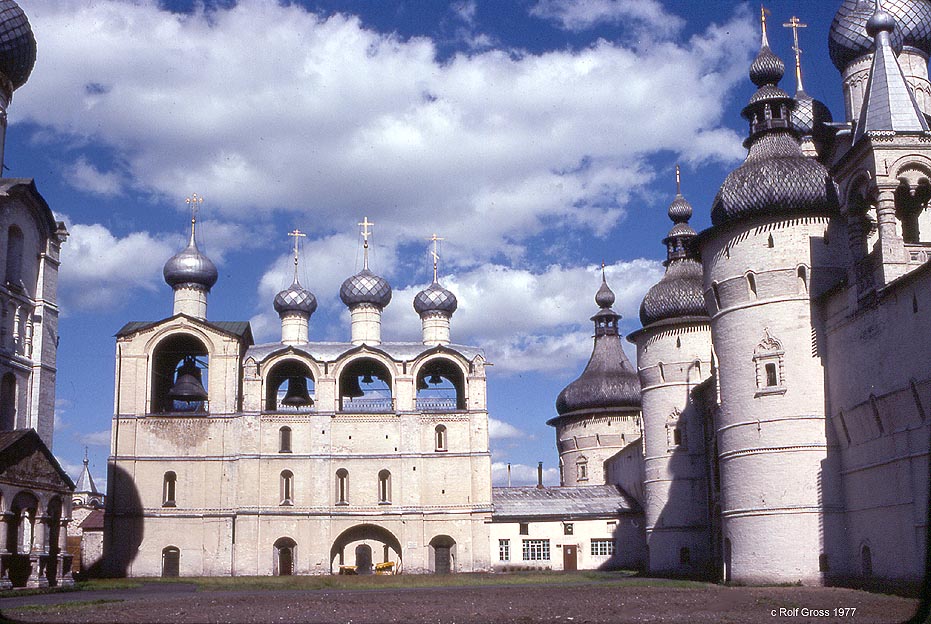
Photo RWFG 1977
The famous carrillion of Rostov outside
the wall
The
Resurrection Gate
17th cent.

Photo RWFG 1977
The Resurrection Gate next to the
Bell Tower
The
Assumption Cathedral
mid 16th cent 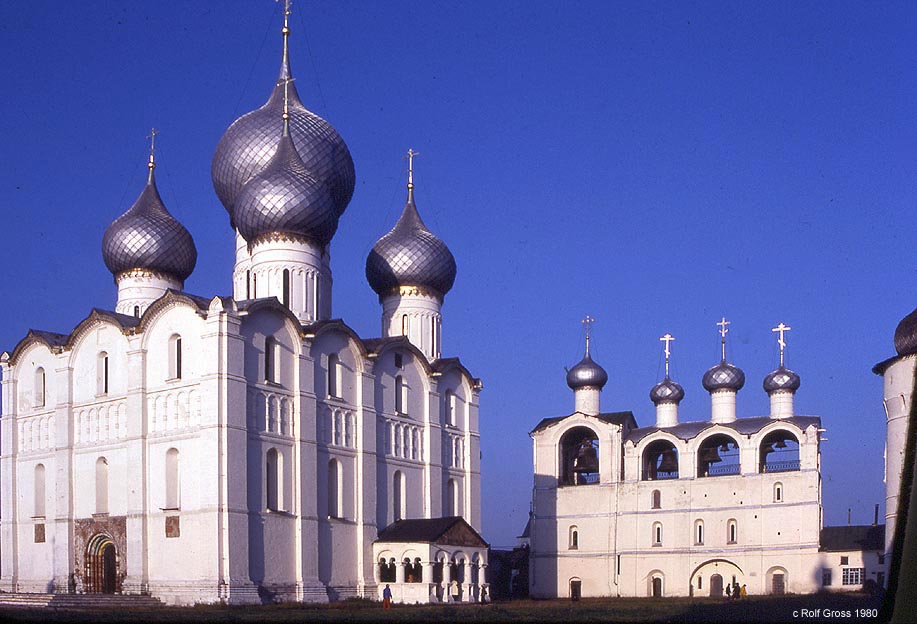
Photo RWFG 1980
The Uspensky Cathedral (Dormition or
Assumption of the Vigin, 16th cent) after it had been restored at the
end of the 70s (Olympic tourists!). - The lower parts of the
cathedral walls are dated to the 12th century. The present church
building is from the 16th to the 17th century.
A
Door in the Wall

Photo RWFG 1977
Entry to the Kreml was expensive, so
we searched the walls for a secret hole and found this door - The
buildings of the Kreml backed by a black cloud.
Inside
the Kreml

Photo RWFG 1977
View of the churches of the Kremlin
from the interior courtyard
The
Church of the Resurrection
17th cent

Photo RWFG 1977
The Voskreseniye-Resurrection Church
above the western Gate
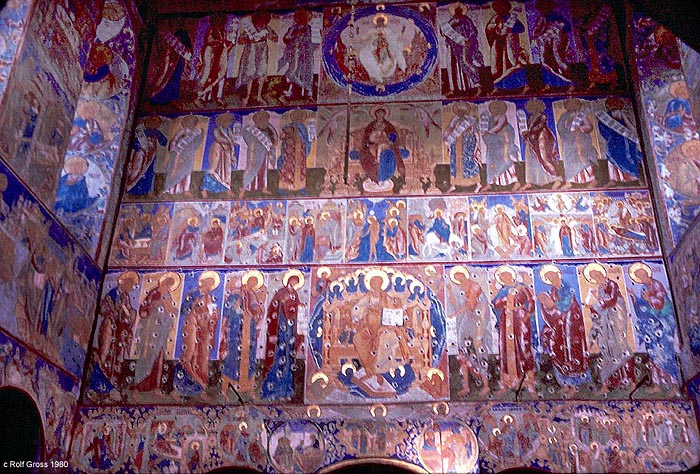
Photo RWFG 1980
The fresco-iconostasis of the
Resurrection Cathedral. It had been plastered over - hence the holes
- and only recently been restored. (1980)
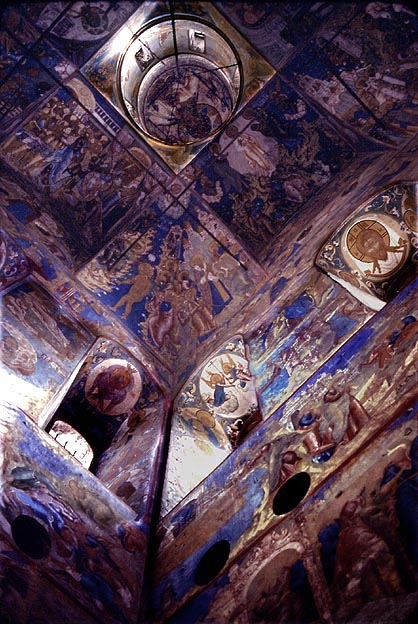
Photo RWFG 1980
The wall paintings of the tambour and
the dome.
The
Resurrection Cathedral reflected in the Bell Pond

Photo RWFG 1980
The Resurrection Cathedral reflected
in the Bell Pond which has formed in the hole in which the biggest
bell had been cast
Granitaya
Palata
1694
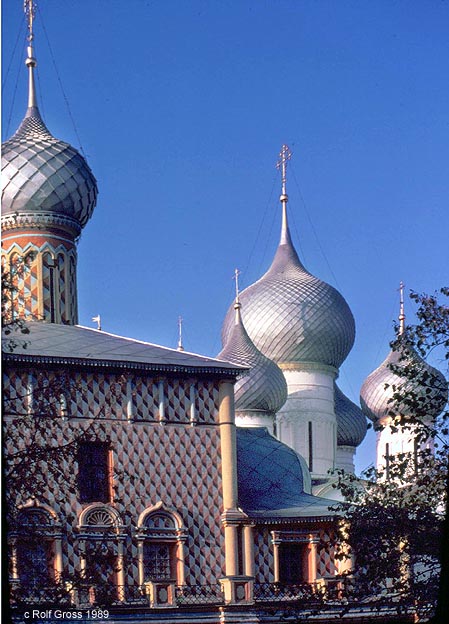
Photo RWFG 1980
Late
Light 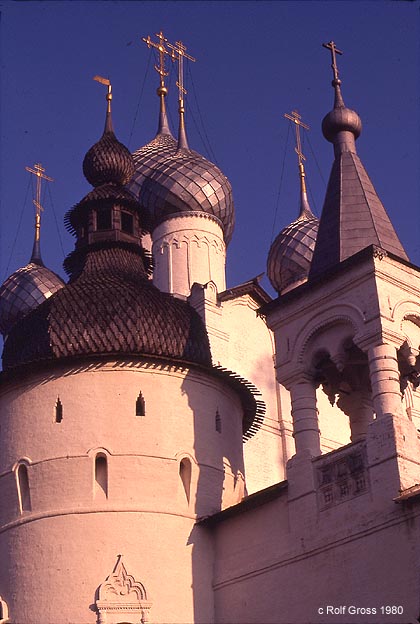
Photo RWFG 1980
Late afternoon in October 1980
Savior-Yakovlevsky
Monastery
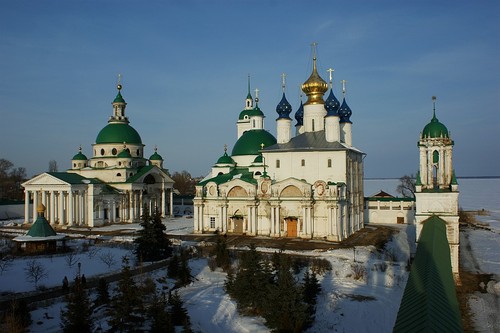
Photo Sergey
Duhanin Panoramio
The Trinity Cathedral later named
Zachatievski Cathedral (1686),
The Monastery was founded in 1389
by Bishop St. Jacob of Rostov. The Church of St. Jacob on the left,
dedicated to the Conception of St. Anna, was built in 1836.
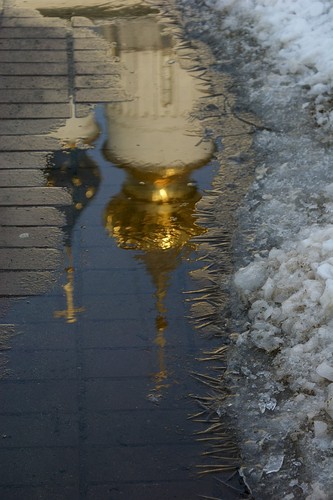
Photo Sergey
Duhanin Panoramio
Another beautiful reflection by Sergey
Duhanin!
Village
Church of Porechye Rybnoye near Rostov
Early
1780s
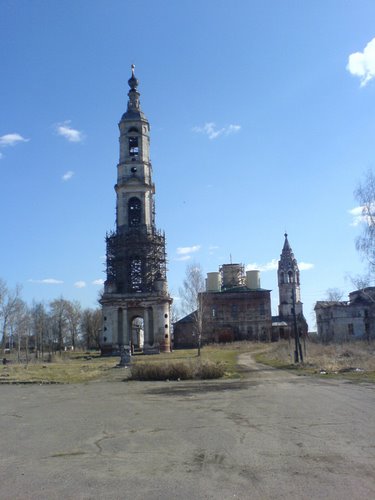
Photo Panoramio
In the villages between Rostov and Pereslavl one finds
numerous church ruins generally of no interest. This ruin in the poor
hamlet of Porechye (1780) would be marginally interesting, if it were
not for fragments of its unusual frescoes:
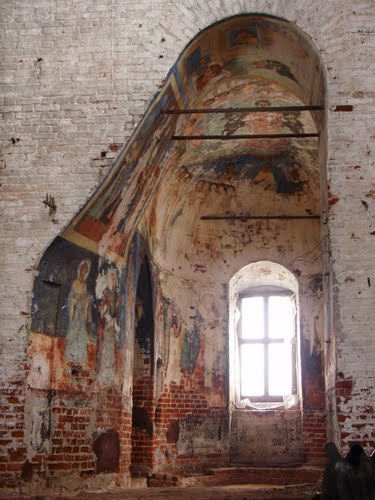
Photo Panoramio

for
a larger photo click on icon-art
"Rejoice in Thee...", fresco in the arch's ceiling.
Beginning 1780s.
Borisoglebsky
Monastery
1550s
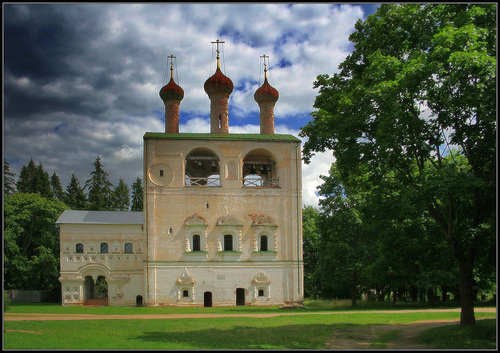
Photo Panoramio
The Bell tower of the Monastery
Borisoglebskiy Monastery. Off the tourist route in a small village north-west of Rostov. Named after Saints Boris and Gleb. The monastery was favoured by Ivan the Terrible who personally supervised the construction of its towered walls and bell-tower around an older cathedral. The only addition made to the monastery after Ivan's death is a superb carved barbican church, commissioned by the metropolitan Iona Sysoevich in the late 17th century.

Photo Panoramio
Cathedral of Boris and Gleb